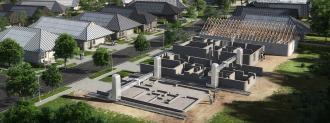Construction startup ICON has announced plans to build the largest community of 3D-printed houses in the world — an undertaking that could take 3D-printed houses from the fringes into the mainstream of housing construction.
The housing shortage: In the past 20 years, U.S. builders have constructed 5.5 million fewer new housing units (single-family homes, apartments, etc.) than what’s needed to support the nation’s increase in households, according to a recent National Association of Realtors report.
“The scale of the problem is so large,” David Bank, one of the report’s authors, told the Wall Street Journal. “We need affordable [housing], we need market-rate, we need single-family, we need multifamily.”
Help wanted: To build those homes, construction companies need skilled workers, but the industry is in the midst of a labor shortage — 85% of respondents to a 2020 National Association of Home Builders (NAHB) survey cited finding workers as their top challenge.
“For 20 years, we haven’t trained and spent money on educating, and at the same time a lot of the industry is retiring,” Ed Brady, president and CEO of the NAHB-associated Home Builders Institute, told Bloomberg. “So the skills gap is going to get worse before it gets better.”
ICON is partnering with leading home construction company Lennar to build a community of 100 3D-printed houses.
3D-printed houses: One way to address this labor shortage is to automate some of the building process using massive 3D printers. These devices extrude a liquid material — using some proprietary type of concrete — in layers that then dry to form the solid walls of a home.
The 3D-printed houses still need laborers to install the electrical, plumbing, and other finishes, but CEO Jason Ballard told AP News that ICON’s system can do the work of up to 20 workers in five or six trades, and unlike humans, it can run 24 hours a day.
As a bonus, 3D printing can also reduce material waste (another factor contributing to the housing shortage) as all of the construction material goes into building the house — there aren’t any bits of lumber or drywall leftover.
The community: 3D-printed houses are still mostly a novelty, though — ICON is one of the industry leaders, and it has built fewer than 100. To truly make an impact on the housing shortage, ICON needs to prove its technology can scale — and it’s now getting a chance to do that.
Lennar Corporation — the second largest home construction company in the U.S. — is now partnering with ICON on what will be the startup’s biggest project to date: a community of 100 3D-printed houses in Austin, Texas.
After ICON 3D-prints the first floor structures, Lennar will add a second story using traditional construction methods and finish off the homes. The project is expected to break ground in 2022, and Ballard is hopeful it’ll help take his company — and 3D-printed houses — to the next level.
“It is an honor and a huge milestone for ICON to partner with Lennar, an elite top-tier homebuilder with a commitment to innovation,” Ballard said in a press release. “We believe this will be a watershed moment in the history of community-scale development and the future breaking into the present.”
We’d love to hear from you! If you have a comment about this article or if you have a tip for a future Freethink story, please email us at [email protected].






